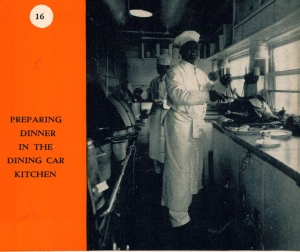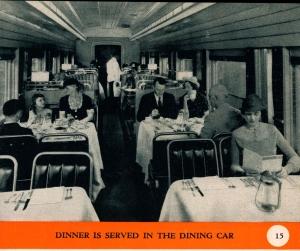
Through the generosity of Mr. Allen H. Tweddle of Newark, a retired railroad conductor, Hagley has received a large mixed collection of railroad books, timetables, internal manuals, postcards and advertising ephemera. Among the many gems is an original 1947 edition of the Pennsylvania Railroad’s Cooking and Service Instructions for its dining car chefs.
Long distance dining cars served mostly first-class passengers who expected first-class meals, and they had to be prepared by a small team of cooks (almost always African Americans) working with fresh ingredients in incredibly cramped quarters. As the preface notes, “In this highly-competitive Post-War Travel Era, it is our duty to prepare the kind of meals that will build our road a reputation for fine food that will be far-reaching as well as rewarding in its effect.” Furthermore, patrons were now more aware of nutrition so that food was not to be over-cooked or left standing.
In contrast to the cramped kitchen, the cookbook runs to a whopping 200 pages (with index) and covers creating everything from scratch to its final presentation on the table. It lists 80 soups, 67 varieties of egg dishes, 55 sauces for entrees, 39 variations on the humble potato, 62 salads plus 20 dressings, and 23 sweet sauces for desserts. Some dishes, like the romaine and beet salad, the baked flounder, or the braised duck, might still appeal to contemporary palates and diet plans, but most are still heavy with salt, sugar, and fats. Try the liver stuffing for roast chicken: sautéed calf’s liver, butter, bread crumbs, onions, two beaten eggs, a half cup of cream, salt, sugar, paprika, chives and lemon juice. Of course, everything would not be on the menu at once, but chefs were expected to be versatile in catering to patron’s appetites.

For the Pennsylvania Railroad in particular, this cookbook represents the apogee of dining car service. After 1946, passenger loads shrank, overall passenger deficits mounted, and the labor-intensive dining cars were a particular drain. Pre-fab meals and early experiments with microwave ovens were soon to follow on all but the most important New York-Chicago and New York-St. Louis trains. Within a decade, food service on the New York-Washington run had degenerated into wretched pre-made sandwiches on “sandwich-cut” white bread, chips, and canned beverages served from a corner stand or a push cart. When the first “Metroliners” started a turn-around in 1969, they not only resembled the inside of an airplane but served airline meals from a microwave. Today, true gourmet dining is possible only on highly-priced “cruise trains” that take passengers on leisurely trips through stunning scenery like the Canadian Rockies or the California wine country.
Christopher T. Baer is the Assistant Curator, Manuscripts and Archives Department at Hagley.
Images from "Railroads at Work" a pamphlet published in 1947 by the American Assocation of Railroads (United States Chamber of Commerce Collection, 1993.230, Box 70)
